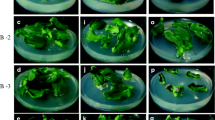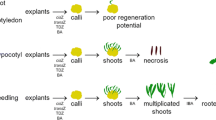Summary
Shoot regeneration was investigated on explants from different leaves and leaflets of three potato cultivars Posmo, Folva and Oleva. Explants were excised from glasshouse grown plants and grown for 6 days on callus induction medium with indole-3-acetic acid or 2,4-dichlorophenoxyacetic acid. Explants were then transferred to auxin free shoot regeneration medium with gibberellic acid and 6-benzyladenine or zeatin. By using the optimum combinations and concentrations of plant growth regulators and by excision of explants from particular regions of proximal leaflets from newly unfolded leaves, shoot regeneration frequencies of 97.0% were obtained for cv. Posmo and 32.1% for cv. Folva. Shoot regeneration frequency of cv. Oleva was very low and could not be improved by the different treatments.
Similar content being viewed by others
References
Barcelo, P., P.A. Lazzeri, A. Martin & H. Lörz, 1992. Competence of cereal leaf cells. II. Influence of auxin, ammonium and explant age on regeneration.Journal of Plant Physiology 139: 448–454.
Dale, P.J. & K.K. Hampson. 1995. An assessment of morphogenic and transformation efficiency in a range of varieties of potato (Solanum tuberosum L.).Euphytica 85: 101–108.
Davies, M.E. & M.M. Dale, 1979. Factors affecting in vitro shoot regeneration on leaf discs ofSolanum laciniatum Ait.Zeitschrift für Pflanzenphysiologie 92: 51–60.
Edwards, G.A., A. Hepher, S.P. Clerk & D. Boulter, 1991. Pea lectin is correctly processed, stable and active in leaves of transgenic potato plants.Plant Molecular Biology 17: 89–100.
Hoekema, A., M.J. Huisman, L. Molendijk, P.J.M. van den Elzen & B.J.C. Cornelissen, 1989. The genetic engineering of two commercial potato cultivars for resistance to potato virus X.Bio/Technology 7: 273–278.
Hulme, J.S., E.S. Higgins & R. Shields, 1992. An efficient genotype-independent method for regeneration of potato plants from leaf tissue.Plant Cell. Tissue and Organ Culture 31: 161–167.
Jarret, R.L., P.M. Hasegawa & H.T. Erickson, 1980. Effects of medium components on shoot formation from cultured tuber discs of potato.Journal of the American Society for Horticultural Science 105: 238–242.
McCullagh, P. & J.A. Nelder, 1989. Generalized linear models. Chapman & Hall. London, pp. 511.
Murashige, T. & F. Skoog, 1962. A revised medium for rapid growth and bio assays with tobacco tissue cultures.Physiologia Plantarum 15: 473–497.
Ovesna, J., I. Burdova, L. Krizkova & Z. Opatrny, 1993. Modification of cultivar-specific regeneration capacity of potato explants by phytohormones and byAgrobacterium oncogenes.Biologia Plantarum 35: 199–208.
Raju, M.V.S. & H.E. Mann, 1970. Regenerative studies on the detached leaves ofEcheveria elegans. Anatomy and regeneration of leaves in sterile culture.Canadian Journal of Botany 48: 1887–1891.
SAS Institute Inc., 1996. SAS/STAT® Software: Changes and enhancements. Release 6.11, chap. 10. The genmod procedure. SAS Institute Inc., Cary, NC. USA.
Sheerman, S. & M.W. Bevan, 1988. A rapid transformation method forSolanum tuberosum using binaryAgrobacterium tumefaciens vectors.Plant Cell Reports 7: 13–16.
Sim, G.E., C.J. Goh & C.S. Loh, 1989. Micropropagation ofCitrus mitis Blanco — multiple bud formation from shoot and root explants in the presence of 6-benzylaminopurine.Plant Science 59: 203–210.
Stiekema, W.J., F. Heidekamp, J.D. Louwerse, H.A. Verhoeven & P. Dijkhuis, 1988. Introduction of foreign genes into potato cultivars Bintje and Désirée using anAgrobacterium tumefaciens binary vector.Plant Cell Reports 7: 47–50.
Takayama, S. & M. Misawa, 1982. Factors affecting differentiation and growth in vitro, and a mass-propagation scheme forBegonia×hiemalis.Scientia Horticulturae 16: 65–75.
Visser, R.G.F., E. Jacobsen, A. Hesseling-Meinders, M.J. Schans, B. Witholt & W.J. Feenstra, 1989. Transformation of homozygous diploid potato with anAgrobacterium tumefaciens binary vector system by adventitious shoot regeneration on leaf and stem segments.Plant Molecular Biology 12: 329–337.
Webb, K.J., E.O. Osifo & G.G. Henshaw, 1983. Shoot regeneration from leaflet discs of six cultivars of potato (Solanum tuberosum subsp.tuberosum).Plant Science Letters 30: 1–8.
Welander, M., 1988. Plant regeneration from leaf and stem segments of shoots raised in vitro from mature apple trees.Journal of Plant Physiology 132: 738–744.
Author information
Authors and Affiliations
Rights and permissions
About this article
Cite this article
Hansen, J., Nielsen, B. & Nielsen, S.V.S. In vitro shoot regeneration ofSolanum tuberosum cultivars: interactions of medium composition and leaf, leaflet, and explant position. Potato Res 42, 141–151 (1999). https://doi.org/10.1007/BF02358404
Accepted:
Issue Date:
DOI: https://doi.org/10.1007/BF02358404




